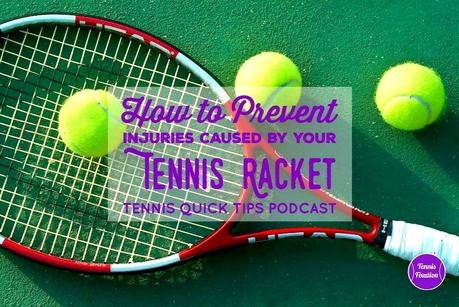If you're anything like me, you're doing a variety of strength and flexibility exercises to stay injury-free so that you can play as much tennis for as long as possible. And you may be practicing hitting with proper technique not only to get better results, but also to keep injuries at bay. But have you made sure that your tennis gear is also helping you stay fit and healthy out on court? Specifically, is your tennis racquet, probably your most important piece of equipment, helping you to play better tennis or could it actually be hurting you? In this episode, we're talking about common tennis injuries that can be caused by your tennis racquet and how you can prevent those from happening to you. You can listen to this episode by clicking on the media player in this post or by listening in with your favorite podcast app. You can also subscribe in iTunes by clicking on this link: tennisfixation.com/itunes.

SHOW NOTES
You can do all of the exercising and technique adjustments you want, but if you truly want to prevent yourself from getting an injury, you need to also make sure that you are playing with the right tennis racquet and that it is properly tuned up for you. So what are the things you need to be aware of about your tennis racket and how to prevent injury?
1. Racquet Stiffness
So way back in Episode 43, which was called All About Tennis Racquets, I told you all about how to pick out your next tennis racquet. And one of the racquet qualities I talked about that is really important to consider was racquet stiffness. Racquet stiffness refers to how much a racquet will flex or bend when it you hit a tennis ball. Racquet stiffness is measured on a scale of 0 to 100, with lower numbers indicating a more flexible racquet and higher numbers indicating a stiffer racquet. I just checked the stiffness of my own racquet and it's a 73.
How can racquet stiffness lead to injury? Well, a racquet that is either too stiff or too flexible can have a negative impact on your arm, wrist, elbow and shoulder. If you have weak arm muscles and/or improper technique and you use a racquet that is too stiff, you can receive an excessive shock or jar to your arm every time you hit the ball. Over time, this can lead to injury. If you racquet is too flexible on the other hand, you may have trouble generating sufficient power and this can lead to overhitting or trying to muscle the ball which can increase the chances of arm, wrist, elbow or shoulder injury.
So, taking racquet stiffness into consideration when you're selecting a racket is obviously important.
2. Racquet Weight and Balance
Another factor to consider is the weight and balance of your racquet. The weight obviously refers to how heavy or light your racquet is, while the balance is how that weight is distributed across the frame of the racquet. Usually, a heavier racquet will give you more power and be more stable and less shock will be transmitted to your arm on ball contact. A lighter racquet allows you to move your racquet more quickly and swing faster but more shock may be transmitted.
The balance of your racquet tells you where the weight is distributed in your racquet. A head-heavy racquet is often a lighter racquet that has more weight in the head of the racquet to allow a player to hit with more power and swing speed. A head-light racquet has more weight toward the handle or grip of the racquet and are easier to manuever and control. There are also balanced racquets with an even distribution of weight and these head-light and balanced racquets may be preferred by players who are stronger and can generate their own racquet head speed.
So what types of injuries can happen if you aren't playing with the proper weight and balance of racquet? If your racquet is too light or is head-heavy, more shock can be transferred to your arm, wrist, elbow and shoulder on ball contact which can lead to injury. You may also need to hit harder or faster with these lighter racquets which again can lead to injury. If your racquet is too heavy, however, you may have trouble hitting the sweet spot consistently or with generating enough head speed and again, these mishits or overhitting can lead directly to injury or even to improper technique changes to compensate which then lead to injury.
So again, you need to take racquet weight and balance into account when selecting a racquet.
Now, just so you know, it is possible to change the weight and balance on your racquet to some extent. If you don't want to run out and buy a new racquet, you can use lead tape to customize your current racquet. I did this with my own racquet and talked about how easy that is to do in Episode 62 which is called Customizing Your Tennis Racquet with Lead Tape.
3. Racquet Grip Size
The size of your racquet grip can also lead to injury if you're not careful. The grip size refers to the diameter of the grip that you hold on your racquet. If your grip is too small, you may have to hold your racquet tighter to keep proper control of it, resulting in your forearm muscles working harder than necessary just to keep hold of the racquet. Similarly, if your grip size is too large, you may also have difficulty keeping a nice tight but relaxed hold of the racquet. You can find out how to determine your proper grip size by listening to Episode 43 which is called All About Tennis Racquets.
And just know that if you want to increase your grip size, you can do that yourself by adding a more padded grip or overwrap to your racquet, something I talked about in Episode 112 which is called Get a Grip on Your Tennis Racquet.
4. String Material and Type
The kind of string you use in your racquet can also contribute to the possibility of injury. As you might expect, I have a whole episode on string called What Kind of Tennis String Should You Use? that can tell you the different kind of strings that are out there and why you would choose one over another.
Regarding string, you should know that if you play with a multi-filament string like nylon or gut, your string may not be as durable but it will be more flexible and usually gives you better feel. Both of these qualities can help with injury prevention.
If you are playing with a monofilament string, this can be very durable and may be preferred if you are going through a lot of strings and are trying to keep costs down. But you should know that the trade-off is that this will be a stiffer string that won't give you as much of a "trampoline" effect when you hit the ball. It can cause excessive jarring to transfer into your arm, wrist and shoulder on ball impact which can, of course, lead to injury.
5. String Tension
The final thing you should be aware of is string tension or how tightly or loosely you have your racquet strung. A lower tension will give your racquet more of that trampoline effect and help add power to your shots. A higher tension will give you less of that effect but more control. And I have an episode all about choosing the right string tension that I recommend you listen to. It's called What's the Best String Tension for Your Racquet? and you can find it at Episode 34.
If you string your racquet too tightly because you're trying to gain control, you may have to hit harder and this can lead to added stress on your arm, wrist, elbow and shoulder. If you string your racquet too loosely, you may have trouble maintaining control leading to adjustments in your technique that once again can lead to injury.
Well, that's a lot to think about I know. And I'm not saying that you need to rush out and buy a new racquet if you weren't planning on doing that before this episode started. I just want you to be aware that these five things are important to look at and some of them can quickly and easily be adjusted on your current racquet. And I think you should take a good look at your racquet and maybe talk to your pro, your stringer or another racquet professional to make sure your racquet is in the best shape possible for your game. This can help you to remain injury free and ensure you keep playing tennis for a long, long time.
RESOURCES AND LINKS FROM THIS EPISODE
For more information on your tennis racket and how to make sure it's in great shape, check out these episodes:
If you're interested in the Tennis Technique Summit, you can get all of the information and sign up for a free virtual ticket by going to:
BUILD YOUR TENNIS FITNESS AND ENDURANCE


© Kim Selzman 2017 All Rights Reserved

